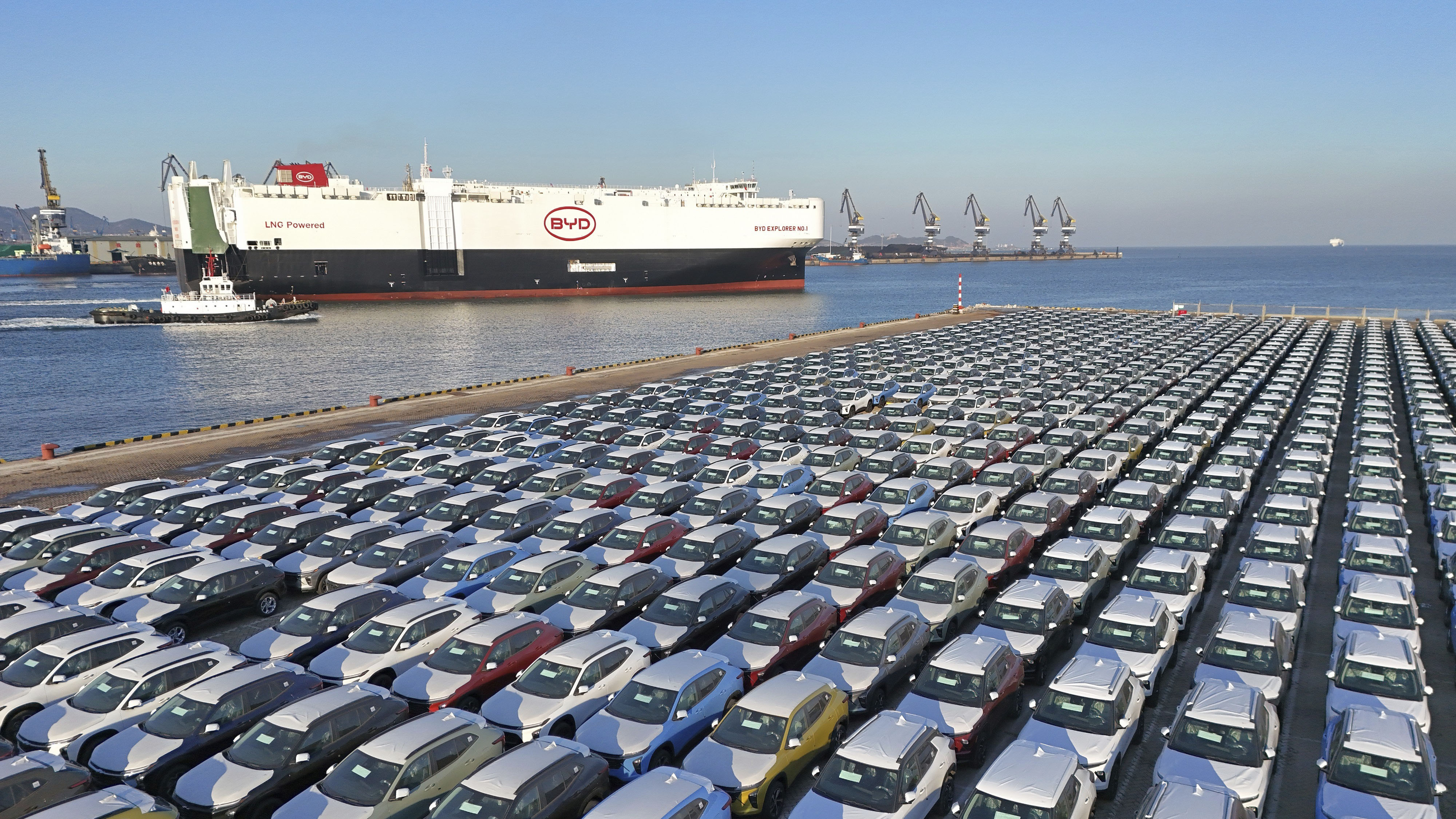Why the world’s biggest EV maker is getting into shipping
BYD has become so popular abroad that the company now needs its own fleet of boats to meet demand.

Earlier this month, a massive ship picked up over 5,000 electric cars from two ports in northern and southern China. Five days later, it passed through Singapore, and it is now headed for India. However, its final destination is in Europe, where most of the cars will be sold.
The ship’s name is BYD Explorer No.1. As the first of a massive fleet that BYD is building, it reflects the Chinese company’s ambition to establish a seafaring business that supports its new role in the global car trade.
BYD, founded by a Chinese metallurgy researcher named Wang Chuanfu in 1995, started out making small batteries for mobile devices. It later expanded its business to automobiles and eventually combined the two to make electric vehicles. In two decades, it became China’s largest EV maker. By the fourth quarter of 2023, it was the world’s.
BYD offers a lot of options, ranging from affordable sedans to luxury SUVs, and there's rising appetite for its cars overseas. In 2023, BYD exported over 240,000 vehicles, up from 55,000 in 2022. But it’s run into a snag: to get the most financial benefit from its exploding popularity abroad, it’s having to expand beyond the car trade into the shipping business.
The shortage of car-carrier vessels
To understand why BYD has made this move, you need to learn a little about how cars are transported across the sea. Usually, the cargo industry uses roll-on/roll-off (RORO) ships. Unlike ships that use a crane to lift up cargo and place it aboard, RORO ships have ramps that allow vehicles to be driven directly on, making the whole process much easier.
But these ships have been in short supply for the past few years. While old vessels have been entering retirement, new ship orders were down because of the 2008 financial crisis and the industry-wide upgrade to more environmentally friendly fuels, leaving a shortfall.
Also, most car companies have longstanding relationships with shipping firms or own their own fleets of boats. For example, Japanese car makers like Nissan and Toyota each have fleets of RORO ships that can carry tens of thousands of cars. But China’s domestic car-carrier vessels represent only 2.8% of global shipping capacity, leaving the Chinese brands few options for getting their cars across the seas.
As a result, their access to RORO ships has become prohibitively expensive. According to Clarksons Research, the intelligence arm of the world’s largest shipping services provider, the price to rent (or charter, as the industry says) a car-carrier ship for a day skyrocketed to $115,000 in 2023, a historical high and close to seven times the average pre-pandemic price, which was around $17,000 in 2019.
New demand to ship cars predominantly comes from China right now. The country is on the verge of becoming the world’s largest car exporter (in fact, it may already have gained that status in 2023, but we won’t know until the official numbers are finalized). It exports a mix of traditional gas cars, electric cars made by Chinese companies, and Tesla cars manufactured in the Giga Shanghai plant.
The shortage of shipping capacity is what’s standing in its way.
Venturing out by themselves
That’s why Chinese auto companies, which have become such prominent exporters thanks to the rise of EVs, are starting to form their own shipping businesses.
News that BYD was looking to buy or charter ships was first reported by the shipping outlet Lloyd’s List in late 2022. In December that year, the company changed its corporate registration to include the business of international cargo shipping and ship management. MIT Technology Review contacted BYD for comment, but it did not respond in time for publication.
BYD Explorer No.1 was delivered at the beginning of this year. The RORO vessel, which can carry 7,000 cars at the same time, is officially registered under Zodiac Maritime, a UK company controlled by the Israeli shipping tycoon Eyal Ofer, but BYD has leased it for an undisclosed period of time. In a press release, BYD says it plans to add seven more vessels to the fleet in the next two years. It also plans to let other companies export their vehicles using BYD’s ships, it says.
For its maiden voyage, the ship is carrying over 5,000 BYD vehicles and heading toward the ports of Vlissingen in the Netherlands and Bremerhaven in Germany, according to Chinese state media outlet Xinhua.
BYD is not the only Chinese automaker making this move. SAIC Motor, a Chinese state-owned company, sold 1.2 million vehicles overseas in 2023, 24% of which were EVs. It formed a RORO shipping subsidiary in 2021, and its newest RORO vessel, the largest of its kind and able to carry 7,600 cars, also set sail for the first time in January. Like BYD Explorer No.1, it’s going to Europe.
While BYD has announced that it will add energy-storing battery tech to its vessels, the RORO ships it’s chartering today are not electric yet. Most of the newer ships can be powered by either traditional fuel or liquefied natural gas, which is a cleaner energy source.
From carrying wood pulp to cars
It will be some time before these Chinese companies finish assembling their sea freight empires, as these massive new ships take years to build. In the meantime, some have turned to creative fixes for the supply shortage: repurposing ships that were designed for other types of cargo.
Particularly, they have their eyes on gigantic ships typically used to import thousands of tons of wood pulp from South America to China, where it’s made into everyday products like tissue, paper, and books. These wood-pulp carriers often end up empty or barely loaded on the way back, because China doesn’t have similar products to export.
However, in recent years Chinese car companies have started to sell their vehicles to the South American continent, and shipping companies saw an opportunity there. China Ocean Shipping Company (COSCO), one of the largest shipping companies in the world, designed a foldable rack that can load cars and stack them up into a wood-pulp carrier. In July last year, COSCO loaded such a ship with over 2,700 cars and sent them to Brazil.
With makeshift arrangements like this and new RORO vessels being built, shipping bottlenecks for Chinese automakers could be significantly reduced in the next couple of years. Having their own fleets or chartering ships from domestic shipping companies could also further drive down costs, making Chinese cars even more competitive abroad.
And just as the auto industry in Japan and South Korea has pushed these two countries to become global leaders in shipping, EVs could make China a major player in the ocean too.
Keep Reading
Most Popular

Happy birthday, baby! What the future holds for those born today
An intelligent digital agent could be a companion for life—and other predictions for the next 125 years.

This researcher wants to replace your brain, little by little
The US government just hired a researcher who thinks we can beat aging with fresh cloned bodies and brain updates.

Here’s how people are actually using AI
Something peculiar and slightly unexpected has happened: people have started forming relationships with AI systems.
Stay connected
Get the latest updates from
MIT Technology Review
Discover special offers, top stories, upcoming events, and more.
